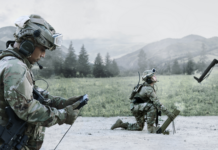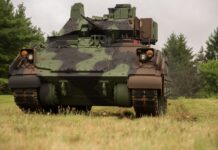The US Army will receive upgraded M1A2C ABRAMS Main Battle Tanks (MBTs) by mid-2028. Although unit numbers were not disclosed, it is known that all existing 1,500 M1A2s will be upgraded to the new standard. The M1A2C is the third version of the System Enhancement Package, previously known as M1A2 SEP V3. The test phase for the successor version SEP V4 has already been initiated, since there is no concrete schedule yet for the replacement of the MBT, which was originally introduced in 1980, with a new system.
The performance enhancements of the M1A2C are based on lessons learned from the Iraq war, while prototypes have already been tested since 2015 and first units have been equipped since Q3 2020.
NEW M1A2C Systems
The long list of improvements concerns all core areas of armoured vehicles: command, firepower, protection and mobility. This is with the aim of simultaneously increasing crew survivability and system efficiency (lethality). Furthermore, it was a goal to create room for growth potential. In this respect, the M1A2C version will be the basic version for future performance enhancements.
While the 120 mm L/44 gun (from Rheinmetall) remained unchanged, the Fire Control System was expanded for modern (programmable) ammunition and can also be used for future ammunition. The most important element for reconnaissance is the new Forward Looking Infrared imaging sensor (FLIR). With higher resolution and digital image processing, the system enables the detection of enemy signatures at greater distances, even in rain, dust or fog. The improvement in FLIR technology helps crews assess light and heat signatures as they emanate from sensors, electronic signal generators and vehicles on the enemy side. New screens and revised operator interfaces enhance situational awareness.
ABRAMS Power
To satisfy the increasing energy hunger of electrical devices of all kinds, an Auxiliary Power Unit (APU) has been installed, which – when the main engine is not running – provides enough power to operate all electrical/electronic devices (silent watch). The APU also relieves the turbine of the main engine, which is known to be particularly uneconomical in the low-load range.
The condition of the equipment is constantly monitored and consolidated in a Vehicle Health Management System (VHMS) so that preventive and predictive maintenance can be planned. In all areas, the use of Line Replaceable Modules (LRMs) is being pushed, which speed up diagnosis and replacement and reduce the duration of service interruptions due to repairs.
New passive elements (some with depleted uranium) are used for improved protection. (Improvised) explosive charges can be repelled more effectively. Mounts are available to accommodate reactive armour such as ABRAMS Reactive Armour Tiles (ARAT) and the TROPHY Active Protection System.
Gerhard Heiming












